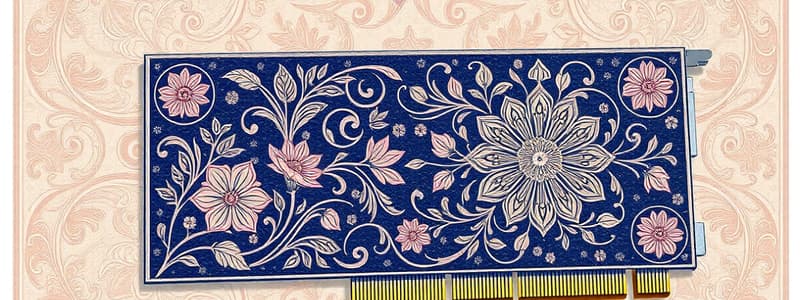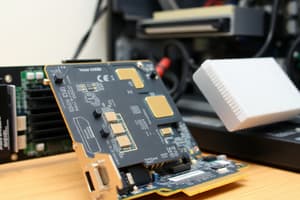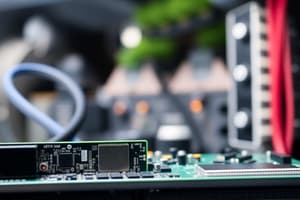Podcast
Questions and Answers
What is the primary use of the PCIe x1 interface?
What is the primary use of the PCIe x1 interface?
- Network interface cards or dedicated sound cards (correct)
- Storage devices
- Motherboard connections
- Dedicated video cards
How does the speed of the PCIe x16 interface compare to the PCIe x1 interface?
How does the speed of the PCIe x16 interface compare to the PCIe x1 interface?
- It is twice as fast
- It is eight times faster
- It is sixteen times faster (correct)
- It is four times faster
What distinctive feature helps secure a PCIe x16 expansion card in its slot?
What distinctive feature helps secure a PCIe x16 expansion card in its slot?
- A hook connecting to the tab (correct)
- A screw at the back
- A clip on the side
- A latch mechanism
What interface replaces the older PCI types for increased speed and functionality?
What interface replaces the older PCI types for increased speed and functionality?
What is the primary function of expansion cards in computers?
What is the primary function of expansion cards in computers?
Which feature helps prevent the wrong installation of an expansion card?
Which feature helps prevent the wrong installation of an expansion card?
What does PCI-X stand for?
What does PCI-X stand for?
How are PCI and PCI-X interfaces primarily different?
How are PCI and PCI-X interfaces primarily different?
Why is it important to identify the bus type used by an expansion card or slot?
Why is it important to identify the bus type used by an expansion card or slot?
Where are PCI-X slots typically found?
Where are PCI-X slots typically found?
What does the term 'expansion bus standard' refer to?
What does the term 'expansion bus standard' refer to?
What characteristic helps identify an expansion slot on a motherboard?
What characteristic helps identify an expansion slot on a motherboard?
Flashcards
Expansion Cards
Expansion Cards
Circuit boards designed for specialized functions like sound or graphics.
Expansion Slots
Expansion Slots
Ports on a motherboard for inserting expansion cards.
Expansion Bus
Expansion Bus
A communication standard determining physical characteristics and communication specifications for expansion cards and slots.
PCI
PCI
Signup and view all the flashcards
PCI-X
PCI-X
Signup and view all the flashcards
Keyed Tab
Keyed Tab
Signup and view all the flashcards
PCI Card Connector
PCI Card Connector
Signup and view all the flashcards
PCI Slot
PCI Slot
Signup and view all the flashcards
PCIe Interface
PCIe Interface
Signup and view all the flashcards
PCIe x1 Interface
PCIe x1 Interface
Signup and view all the flashcards
PCIe x16 Interface
PCIe x16 Interface
Signup and view all the flashcards
PCIe x16 Notch
PCIe x16 Notch
Signup and view all the flashcards
PCIe x16 Hook
PCIe x16 Hook
Signup and view all the flashcards
Study Notes
Expansion Cards and Buses
- Expansion cards are circuit boards adding specific functions (sound, graphics) to a computer.
- They plug into expansion slots on the motherboard.
- This allows computers to keep up with new technologies without needing a complete replacement.
- Expansion cards and slots use an expansion bus standard defining how they communicate.
- Different bus standards aren't compatible.
- Identifying the bus type is key for proper card installation.
Peripheral Component Interconnect (PCI)
- PCI cards have a keyed connector tab with a notch towards the back.
- The motherboard's PCI slot has a corresponding notch.
- The keyed tab prevents incorrect installation.
- PCI cards are usually found in desktop computers.
PCI-X
- PCI-X cards and slots are double the length of standard PCI.
- PCI-X transfer speeds are twice the standard PCI.
- PCI-X is found mainly in server systems.
PCI Express (PCIe)
- PCIe is faster and more feature-rich than PCI and PCI-X.
- PCIe has two main formats:
- PCIe x1: Smaller keyed tab, used for network interface cards (NICs) and sound cards.
- PCIe x16: Longer keyed tab, with a notch near the front and a hook at the back, used for video cards.
- PCIe x16 is 16 times faster than PCIe x1.
Identifying Expansion Buses
- Identifying expansion buses is crucial for PC technicians.
- Visual cues aid in distinguishing between PCIe x1, PCIe x16, PCI, and PCI-X interfaces.
- Differences include tab shape, notch position, and slot length.
- The keyed tab is essential for preventing incorrect installation of an expansion card.
Studying That Suits You
Use AI to generate personalized quizzes and flashcards to suit your learning preferences.




